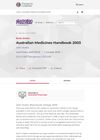Superficial Fungal Infections
October 2019
in “
Australian Journal of General Practice
”

TLDR Accurate diagnosis and treatment are crucial for managing superficial fungal infections, with terbinafine being the best oral treatment for nail infections.
The document provided an overview of superficial fungal infections, focusing on tinea, which affected the skin, nails, and hair. It highlighted the importance of accurate diagnosis and treatment to prevent complications like cellulitis, ulcers, and alopecia. Terbinafine was identified as a superior oral therapy for onychomycosis, while griseofulvin was less effective for tinea corporis and not recommended for onychomycosis. Laser therapy was not recommended as a first-line treatment. Preventive measures included addressing risk factors and using topical antifungal therapy as prophylaxis. The authors emphasized the need for confirmed diagnosis before prescribing oral antifungal therapy due to the presence of tinea mimics.

